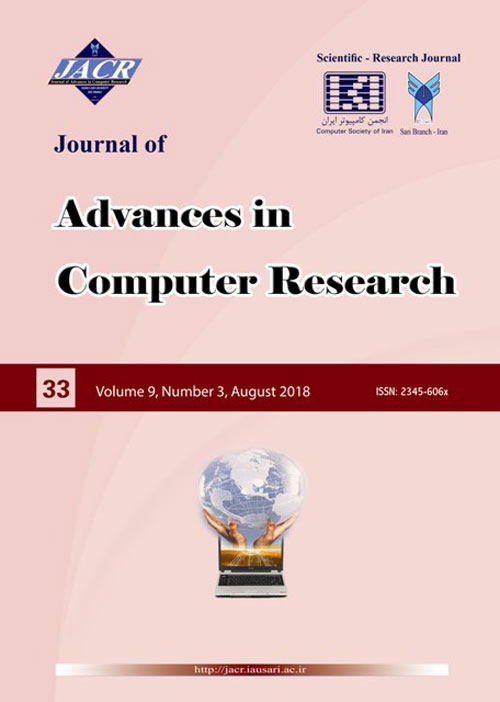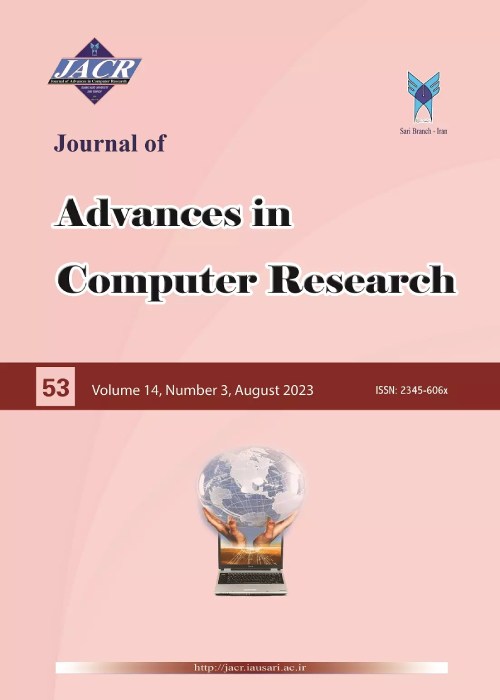فهرست مطالب

Journal of Advances in Computer Research
Volume:9 Issue: 3, Summer 2018
- تاریخ انتشار: 1397/04/24
- تعداد عناوین: 8
-
Pages 1-21In this paper, a new model based on the thevenin equivalent circuit for investigating the ultra-saturation phenomenon during the energization of a loaded power transformer is presented and its effect on the differential protection of the transformer is considered. The ultra-saturation phenomenon causes the mal-operation of the power transformer differential protection. So, the description and control of the ultra-saturation phenomenon is necessary for preventing of the false trip of the differential protection. In this paper, to model the ultra-saturation phenomenon, the nonlinear characteristic of the transformer core, the effect of current transformer, and the core losses are taken into account. It is assumed that the load of the transformer is a resistive and inductive load. Also, the effect of the residual flux and inception angle on the ultra-saturation phenomenon are investigated. The results show that the ultra-saturation phenomenon poses a great problem for protective relaying of power transformers. The outcomes of this research can further be used as hints for substation operation personnel as well as for the development of new protection stabilization criteria, which is not discussed further in this paper. The explanation of the ultra-saturation phenomena is the first step toward developing new ideas and criteria for more reliable transformer protection that would better handle such abnormal cases than currently employed relaying equipment. In this paper, the fourth-order Runge-Kutta method is used to solve the equations and simulation of the ultra-saturation phenomenon is done by MATLAB program.Keywords: Loaded Transformer Energization, Transformer Differential Protection, Ultra-Saturation Phenomenon, Mal-Operation
-
Pages 23-37Seismic hazard assessment like many other issues in seismology is a complicated problem, which is due to a variety of parameters affecting the occurrence of an earthquake. Uncertainty, which is a result of vagueness and incompleteness of the data, should be considered in a rational way. Using fuzzy method makes it possible to allow for uncertainties to be considered. Fuzzy inference system, is used since the study based on uncertainty estimation of seismic hazard for the region Qom, is done. First, the input parameters required for Seismic hazard assessment is fuzzified by fuzzification (in Matlab fuzzy tool-box) and the membership functions are used to set the degree of membership. The inference engine produces fuzzified sets using the output from the fuzzification stage and the rule base engine. The fuzzified sets are then defuzzified using the center of the area. Eventually, using a set of attained coordinates for the Holy Shrine (Masoumeh) a deterministic estimation of seismic hazard is made using both the usual deterministic approaches and the Mamdani fuzzy Inference System. Our results show a peak ground acceleration value of 0.43g using fuzzy inference system.Keywords: Fuzzy Inference System, Seismic Hazard, Deterministic Approach, Peak Ground Acceleration
-
Pages 39-53Wireless sensor networks are often located in areas where access to them is difficult or dangerous. Today, in wireless sensor networks, cluster-based routing protocols by dividing sensor nodes into distinct clusters and selecting local head-clusters to combine and send information of each cluster to the base station and balanced energy consumption by network nodes, get the best performance in terms of increasing longevity and preservation network coverage as compared to other routine methods. Their main purpose is to control the danger area and transfer data to a sink. Therefore, connecting to sensor networks and coverage rate of controlled area is one of the most important concerns to achieve these goals. In this paper, to cluster wireless sensor networks, a method using the Imperialistcompetitive evolutionary algorithm is purposed that divides wireless sensor nodes into balanced clusters, in addition to, several mobile robots has been used for improving power dissipation of network, to assist in the transmission of sensor networks and improve network connectivity and coverage rate of the controlled area. In this research, the sensor network is based on an islets-based topology that has been used robots to detect and enhance connectivity and cover cavities that are largely around the sensors. The simulation results show that our new model can greatly improve the network coverage connectivity criteria. The simulation results show its successful performance in increasing longevity of the wireless sensor network.Keywords: wireless sensor networks, Robots, Imperialist Competitive Algorithm, Connectivity, Network Coverage
-
Pages 55-70Mobile Ad Hoc Networks (MANET) can be considered as a class of unstructured networks created by a number of autonomous wireless and sensor nodes. The inherent characteristics of such networks have made specific applications, such as multimedia transfer and challenging. Basically, the functionality of a node and very few resources directly affect the delivery of packets which depends on the quality of the selected route. Since the nodes in MANET get their energy and power from batteries or other end-to-end resources, the most important criterion to design an optimal system is energy conservation. The purpose of this paper was to increase the efficiency of the OLSR routing protocol by generating new parameters and considering the amount of nodes energy. In this method, the optimal route was selected based on the remained energy in the middle nodes, the distance between the nodes and the number of steps. Therefore, the present paper used a genetic algorithm-based approach for optimal routing in the OLSR protocol based on the remained energy of each node. It used the weight factor which has been determined based 111on energy consumption combined with shortest routes. It considered the energy factor of each node in routing and selected the optimal route.Keywords: Mobile Ad Hoc Network (MANET), Routing Protocol, Energy-Based Routing, Genetic Algorithm
-
Pages 71-86Data transmission security has become an extremely important field of research. Steganography is an art of hiding information in image, audio and video files in a way that would meet the security requirements in the form of overt or covert. In this study, we propose a new hybrid steganography technique for color images that hide secret messages in the frequency domain of a cover image's blue channel. Hence this method provide robustness against attacks, eavesdropping and capacity. In addition, we use coding and compression algorithms to obtain high capacity along with security and maintains the quality of the cover image with considerable high value PSNR. In this paper a secret message can be either an image or text and our purpose is to improve three important parameters in steganography. Peak Signal to Noise Ratio (PSNR) values measures any steganography techniques performance. Higher PSNR values indicate that the performance of the system is better.Keywords: Steganography, Frequency, Spatial Domain, Coding, Compression Algorithms
-
Pages 87-101As moving to big data world where data is increasing in unstructured way with high velocity, there is a need of data-store to store this bundle amount of data. Traditionally, relational databases are used which are now not compatible to handle this large amount of data, so it is needed to move on to non-relational data-stores. In the current study, we have proposed an extension of the MongoDB architecture to support FMQL by integrating a software layer on MongoDB translating FMQL queries to corresponding F-XML queries. Flexible queries have been done in the oriented-document database (MongoDB) by using fuzzy xml commands in the document-centric (MongoDB) injected uncertainty and expressed this commands based on F-XML and by using uncertainty. We used the fuzzy properties to improve query in the document-oriented database (MongoDB) and we showed the Position of the proposed method by the implementation and evaluation of a case study.Keywords: NOSQL, Document-Oriented Database (MongoDB), Fuzzy Query, XML, F-XML
-
Pages 103-132An efficient assignment and scheduling of tasks is one of the key elements in effective utilization of heterogeneous multiprocessor systems. The task scheduling problem has been proven to be NP-hard is the reason why we used meta-heuristic methods for finding a suboptimal schedule. In this paper we proposed a new approach using TRIZ (specially 40 inventive principles). The basic idea of this approach is to exploit the advantages of heuristic-based algorithms to reduce space search and the time needed to find good solutions. The proposed algorithm improves the performance of genetic algorithm through significant changes in its genetic functions and introduction of new operators that guarantee sample variety and consistent coverage of the whole space. The achieved results of running this algorithm on the graphs of real-world applications and random graphs in heterogeneous computing systems with a wide range of characteristics, indicated significant improvements of efficiency of the proposed algorithm compared with other task scheduling algorithms. Although the proposed algorithm needs lower repetitions than their genetic counterparts, it needs high frequency of repetition to produce the desired answer. This is a drawback for this algorithm compared to heuristic algorithms such as CPOP and HEFT.Keywords: Genetic Algorithms, Task Scheduling, TRIZ, Meta Heuristic
-
Pages 133-151A mobile ad-hoc network (MANET), a set of wirelessly connected sensor nodes, is a dynamic system that executes hop-by-hop routing independently with no external help of any infrastructure. Proper selection of cluster heads can increase the life time of the Ad-hoc network by decreasing the energy consumption. Although different methods have been successfully proposed by researchers to tackle this problem, nearly all of them have the deficiency of providing a single combination of head clusters as the solution. On the contrary, in our proposed method, using a Multi-Objective Genetic Algorithm, a set of near optimum solutions is provided. In the proposed method, energy consumption, number of cluster heads, coverage and degree difference are considered as objectives. Numerical results reveal that the proposed algorithm can find better solutions when compared to conventional methods in this area namely, weighted clustering algorithm (WCA), comprehensive learning particle swarm optimization (CLPSO) and multi objective particle swarm optimization(MOPSO).Keywords: Mobile Ad-Hoc Network, Multi Objective Genetic Algorithm, Cluster-Head


